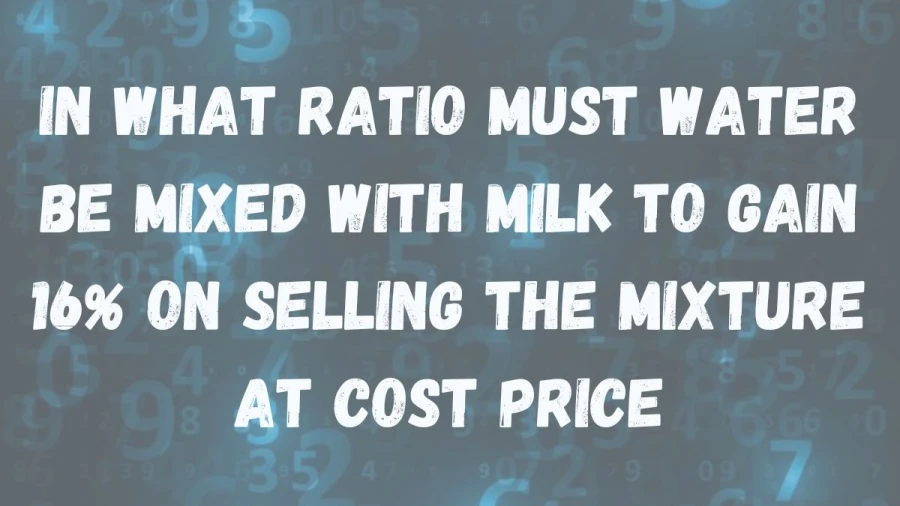If you happen to be viewing the article In what ratio must water be mixed with milk to gain 16% on selling the mixture at cost price?? on the website Math Hello Kitty, there are a couple of convenient ways for you to navigate through the content. You have the option to simply scroll down and leisurely read each section at your own pace. Alternatively, if you’re in a rush or looking for specific information, you can swiftly click on the table of contents provided. This will instantly direct you to the exact section that contains the information you need most urgently.
Find out how to mix water and milk to make a 16% profit when selling the mix for the same price you paid to make it.
In what ratio must water be mixed with milk to gain 16% on selling the mixture at cost price?
The ratio of water and milk in the mixture is 4:25.
Explanation
Let’s solve the problem step by step:
Given:
- Let the Cost price of 1 liter of milk = Rs. 1
- Selling price of mixture (milk and water) = Cost price of milk = Rs. 1
- Gain = 16%
First, let’s calculate the cost price of the mixture: Cost price of mixture = 100 / (100 + gain%) * Selling price of mixture = 100 / (100 + 16) * 1 = 100 / 116 = Rs. 25/29 per liter
Now, let’s consider the cost price of 1 liter of water, which we denote as C. Since water has no cost, C = 0.
The cost price of 1 liter of milk is already given as Rs. 1.
Now, let’s find the mean price, denoted by M, which is the cost price of the mixture, i.e., Rs. 25/29.
So, we have:
- Difference between milk’s cost price and mean price (1 – 25/29) = 4/29
- Difference between mean price and water’s cost price (25/29 – 0) = 25/29
Thus, the ratio of water to milk in the mixture is 4/29 to 25/29.
To simplify, we multiply both sides by 29 to get rid of the denominators:
So, in a 4:25 ratio, water must be mixed with milk to gain 16% on selling the mixture at the cost price.
Ratio and Proportion in Mathematics
Ratio and proportion are fundamental concepts in mathematics that are used to compare quantities and establish relationships between them.
Ratio: A ratio is a comparison of two quantities by division. It is often written in the form a:b or a/b, where a and b are non-negative numbers and b is not equal to zero. Ratios can represent various comparisons such as the comparison of lengths, weights, volumes, etc. For example, if you have 3 red balls and 5 blue balls, the ratio of red balls to blue balls is 3:5.
Proportion: A proportion is an equation that states two ratios are equal. It typically involves four numbers or expressions and can be written in the form a/b = c/d, where a, b, c, and d are numbers or expressions. When you have a proportion, you can use it to solve for unknown quantities. For example, if you know that 2/3 = x/6, you can solve for x by cross-multiplying: 2 × 6 = 3 × x, which simplifies to 12 = 3x, and then solve for x to find that x = 4.
Application: Ratio and proportion are used in various real-life situations such as cooking (recipe proportions), finance (calculating interest rates and proportions of investments), geometry (similar figures), and many other fields of science and engineering.
Understanding ratios and proportions is essential for solving many mathematical problems and for interpreting relationships between quantities in the real world.
Thank you so much for taking the time to read the article titled In what ratio must water be mixed with milk to gain 16% on selling the mixture at cost price? written by Math Hello Kitty. Your support means a lot to us! We are glad that you found this article useful. If you have any feedback or thoughts, we would love to hear from you. Don’t forget to leave a comment and review on our website to help introduce it to others. Once again, we sincerely appreciate your support and thank you for being a valued reader!
Source: Math Hello Kitty
Categories: Math

